Key takeaways
- Mailchimp’s audience segmentation and automation features enhance campaign communication, allowing for personalized messaging and efficient engagement without burnout.
- Data analytics provides insights on campaign effectiveness, helping to refine messaging and improve supporter interaction.
- Building a quality supporter list through meaningful interactions and tailored signup forms fosters community and active engagement.
- Authenticity in communication, combined with timely outreach, strengthens personal connections and mobilizes supporter action effectively.
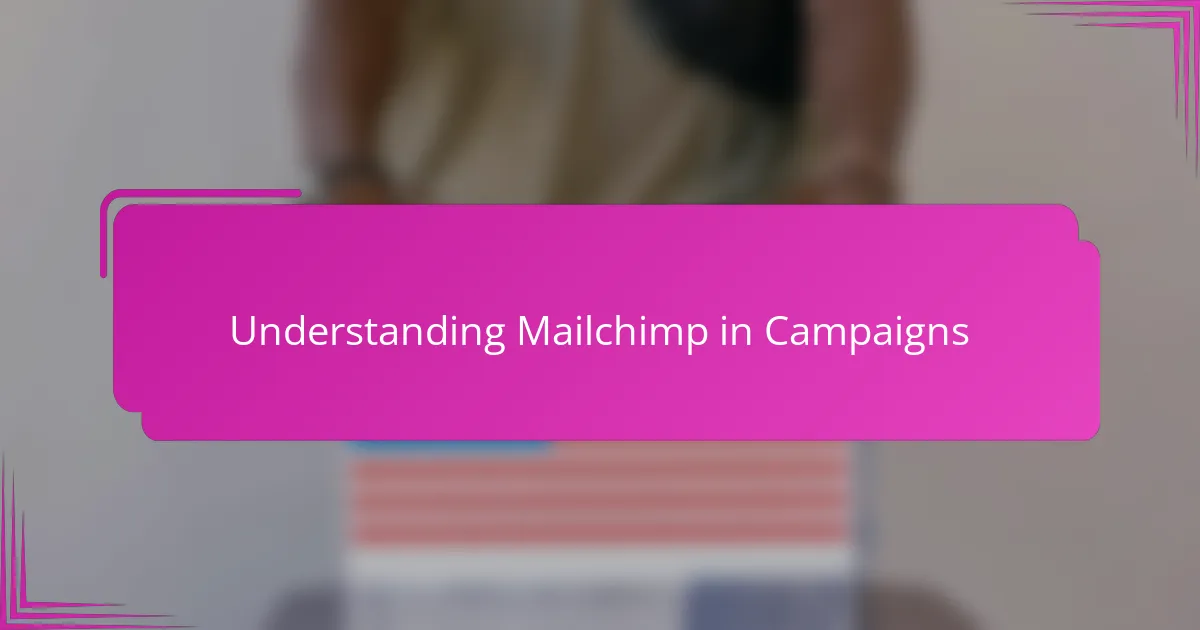
Understanding Mailchimp in Campaigns
Mailchimp isn’t just another email tool; it’s become the backbone of how I connect with supporters during campaigns. I remember the first time I used it—I was amazed at how easily I could segment my audience, sending tailored messages that actually resonated. Have you ever wondered how some emails just feel personal? That’s the power of smart segmentation.
What really struck me is how Mailchimp’s automation features took the pressure off, especially during crunch time. Setting up drip campaigns meant I could engage voters consistently without burning out. It’s like having a virtual team member who works around the clock, making sure no one feels forgotten.
But beyond the tools, what matters most is the data — Mailchimp’s analytics allowed me to see which messages sparked action and which fell flat. It taught me to listen to my audience in a way I hadn’t before, transforming cold contacts into active supporters. Isn’t that what every campaign dreams of?
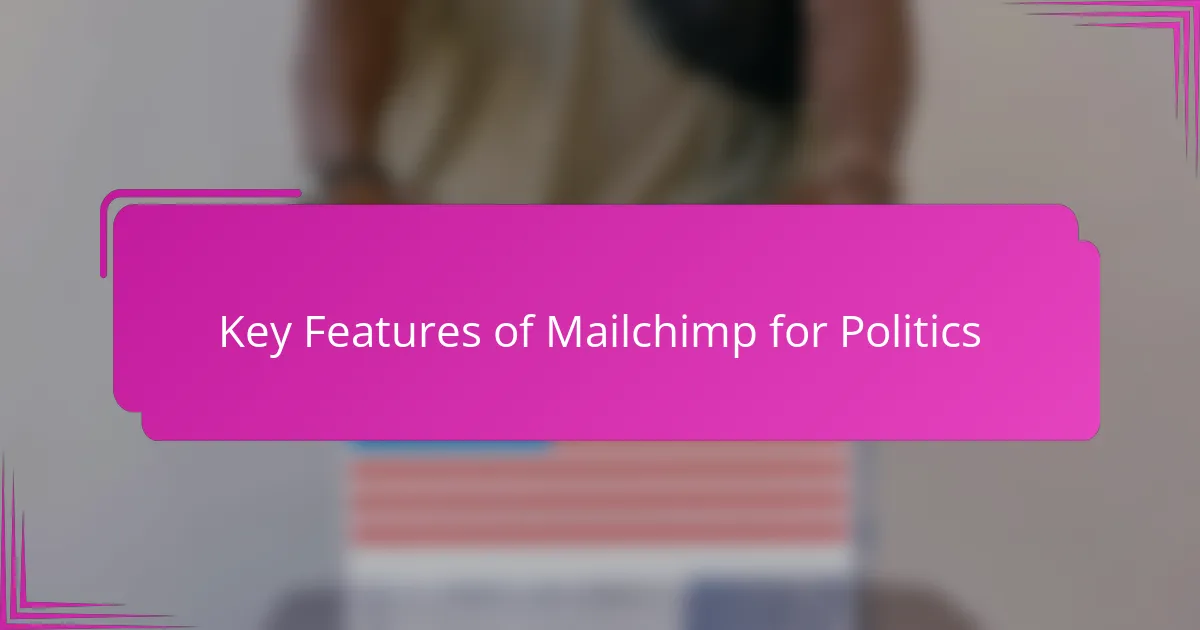
Key Features of Mailchimp for Politics
One feature that stood out to me was the flexibility of Mailchimp’s audience segmentation. I could slice and dice my supporter list by location, past donation history, or even engagement level. This meant I wasn’t just sending generic blasts; I was speaking directly to each group’s interests and concerns, which made my messages feel authentic and timely.
Another game-changer has been the built-in automation tools. I recall one stressful weekend where I scheduled a series of follow-ups to launch right after a big town hall event. Instead of scrambling to manually send emails, Mailchimp handled it all seamlessly, allowing me to focus on meeting voters. Isn’t it incredible when technology frees you up to do what really matters on the ground?
The analytics dashboard was like a campaign compass for me. Seeing open rates, click-throughs, and subscriber growth in real time shaped how I adjusted messaging and calls to action. It’s a reminder that smart data isn’t just numbers—it’s the voice of your supporters telling you what moves them. Have you ever wished you had that kind of insight before sending an important email?
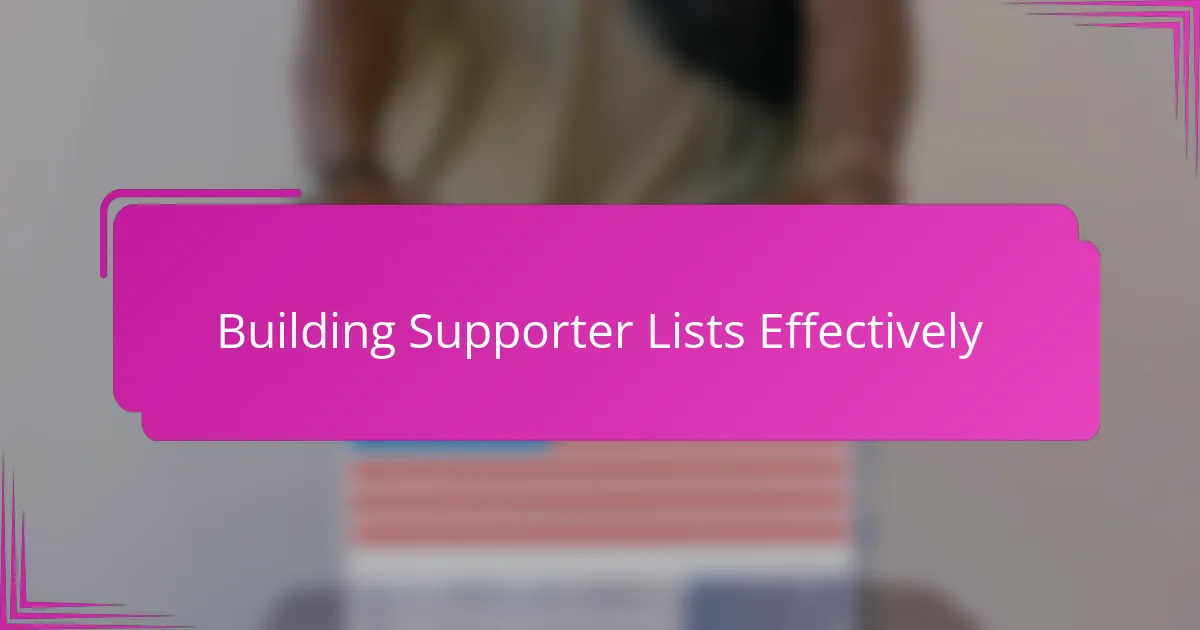
Building Supporter Lists Effectively
Building a strong supporter list isn’t about collecting as many emails as possible; it’s about quality and relevance. Early in my campaign, I focused on capturing contacts from meaningful interactions—like town halls and local events—because those were the moments when people were truly engaged. Have you noticed how a list gathered with care feels more like a community than just names on a spreadsheet?
One strategy I found invaluable was creating multiple signup forms tailored to specific interests or locations. When I adjusted the forms to reflect a voter’s passion—whether it was education reform or economic growth—I saw a noticeable jump in signups and, more importantly, active engagement. It made me realize that personalized entry points build a foundation of trust before any email is even sent.
It’s tempting to buy lists or scrape contacts, but I learned the hard way that this often backfires. Those disconnected emails rarely respond, and worse, they hurt deliverability. So I invested time in nurturing every new subscriber with a welcome series that clearly stated who I was and why their involvement mattered. What’s the point of a list if the people on it don’t feel like part of something bigger?
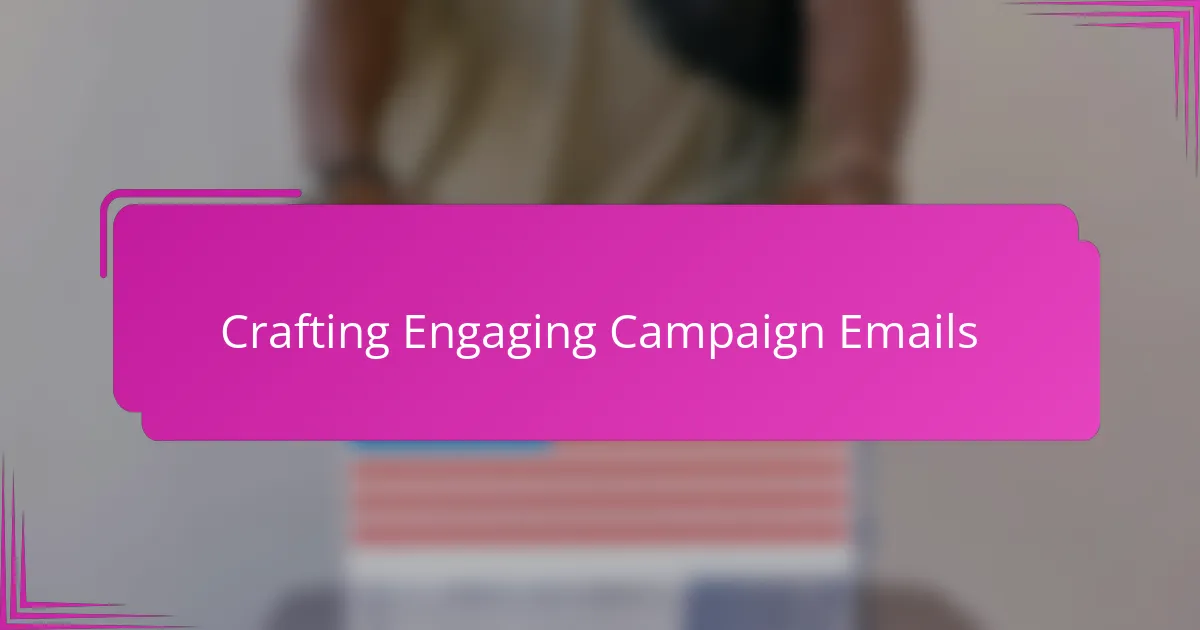
Crafting Engaging Campaign Emails
Crafting campaign emails that actually grab attention felt like decoding a secret for me. Early on, I learned that a catchy subject line wasn’t enough—what really hooked supporters was speaking to their values and concerns in a tone that felt genuine, like a conversation rather than a broadcast. Have you ever opened an email that made you stop and think, “Yes, this is about me”?
I also discovered how important it was to keep things concise but impactful. Supporters are busy, and cluttered emails just get ignored. So, I made it a point to lead with the most urgent message, followed by a clear call to action that felt natural, not pushy. This simple tweak boosted my open and click rates more than I expected.
One moment that sticks with me was when a heartfelt email about local issues sparked dozens of replies—real conversations, not just automated clicks. That’s when I understood: engagement isn’t just about sending messages, it’s about sparking a two-way connection. Doesn’t that change how you view every email you send?
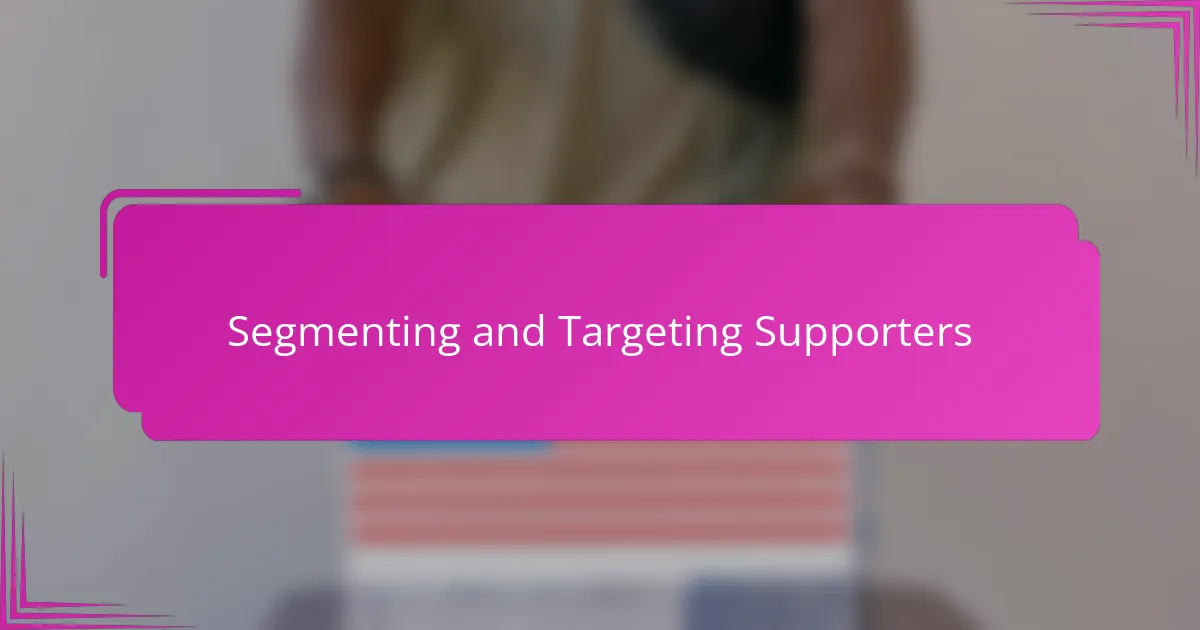
Segmenting and Targeting Supporters
Segmenting supporters by demographic details like age, location, and voting history was a game-changer for me. I remember tailoring messages specifically for suburban moms worried about education, and the response was immediate and heartfelt. Have you ever noticed how a message that “gets” your concerns feels like a genuine conversation rather than a sales pitch?
Targeting wasn’t just about who received the email but also when and how often they heard from me. I honed in on volunteers who showed early enthusiasm, sending them timely calls to action that turned interest into real momentum. That sense of urgency, combined with understanding each group’s priorities, made my outreach feel purposeful and respectful—something I think every campaign strives for.
What struck me most was that segmentation revealed hidden pockets of support I might have overlooked otherwise. Groups with different concerns needed different approaches, and Mailchimp’s tools made that manageable. Isn’t it fascinating how breaking down a crowd into smaller, thoughtful groups can actually make the campaign feel more personal and connected?
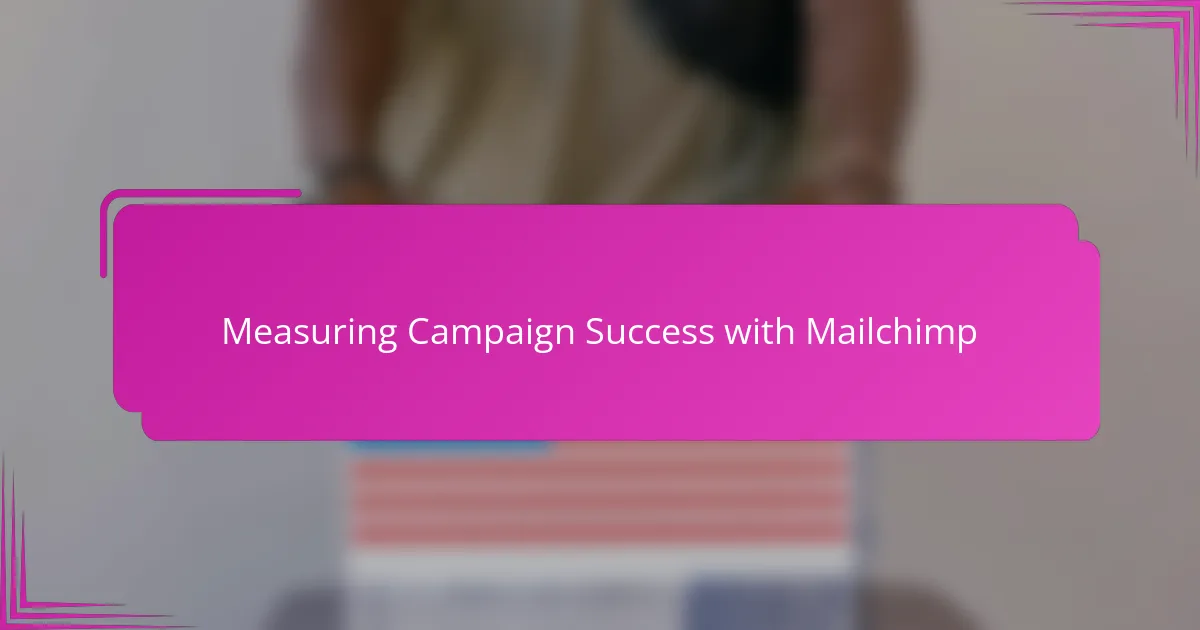
Measuring Campaign Success with Mailchimp
Mailchimp’s reporting tools became my campaign’s north star. Tracking open rates and click-throughs told me whether my emails were actually striking a chord or just drifting into the void. Have you ever felt that moment of doubt after hitting send? Those numbers helped me move past that and sharpen every message.
One time, I noticed a dip in engagement after a series of emails. Instead of panicking, I dove into the data and realized I needed to adjust my call to action. Making that small change based on real-time feedback gave my campaign a new lease of life. That’s the power of measuring success—all about staying nimble and responsive.
But it wasn’t just about the hard metrics. When I saw subscriber growth picking up after launching a volunteer spotlight series, I knew I was connecting on a deeper level. Data revealed more than clicks; it showed me when supporters were feeling seen and motivated. Isn’t that what every campaigner hopes to achieve?

Personal Mobilization Strategies Explained
One approach that really shaped my mobilization efforts was focusing on authenticity. I found that sharing personal stories and addressing supporters by name made a huge difference. Don’t you think it’s easier to rally behind a message that feels like it’s coming from a real person rather than a faceless campaign?
I also realized early on that timing is everything. Sending an email at the right moment—whether to remind volunteers about an event or to push for last-minute donations—created a sense of urgency that motivated action. It’s like catching someone at the perfect moment when they’re ready to step up.
Perhaps the most powerful lesson was learning to listen, not just speak. By paying attention to which messages sparked replies or clicks, I could tailor follow-ups that met supporters where they were. Have you ever felt the difference when someone truly hears you? That’s the kind of connection personal mobilization strives for.